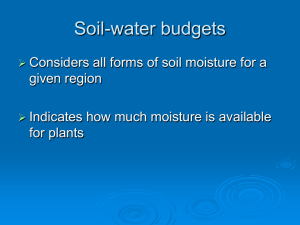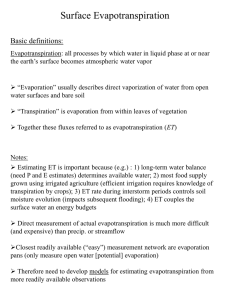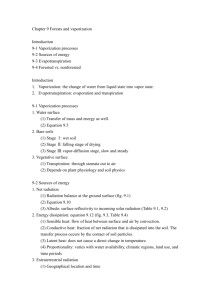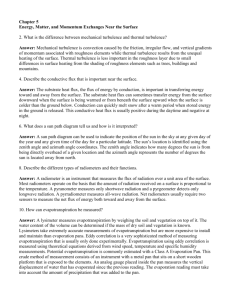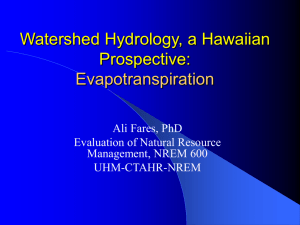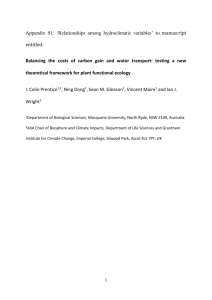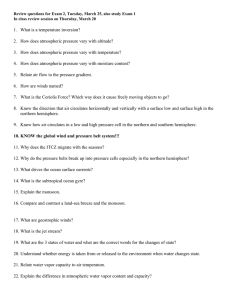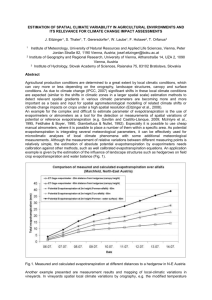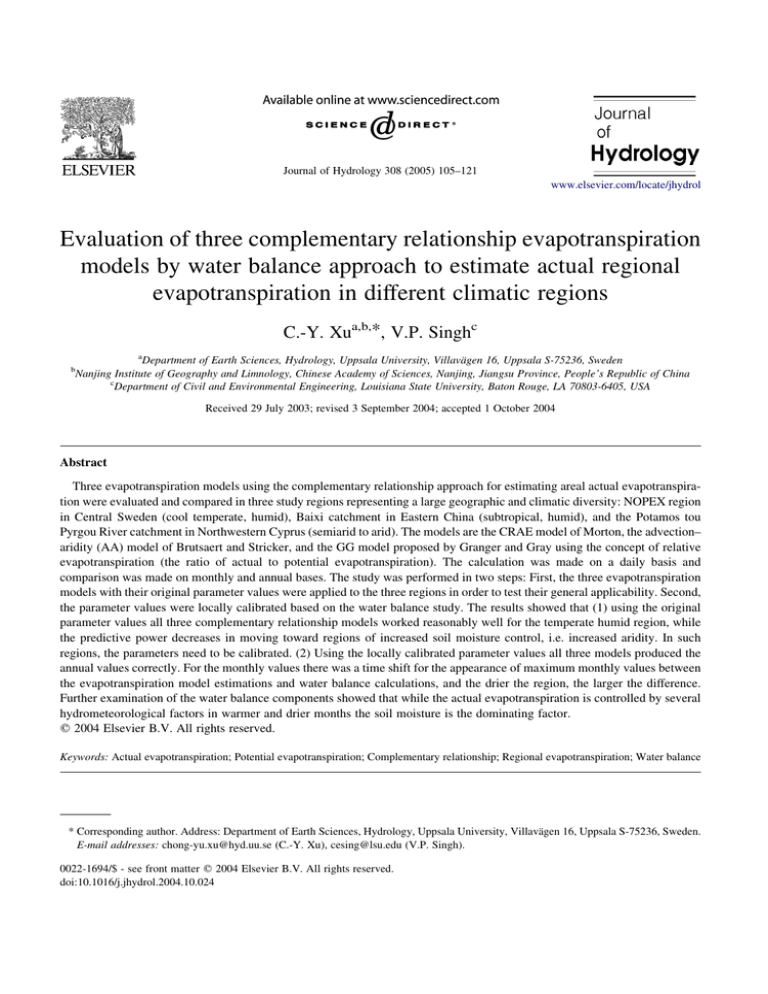
Journal of Hydrology 308 (2005) 105–121
www.elsevier.com/locate/jhydrol
Evaluation of three complementary relationship evapotranspiration
models by water balance approach to estimate actual regional
evapotranspiration in different climatic regions
C.-Y. Xua,b,*, V.P. Singhc
a
Department of Earth Sciences, Hydrology, Uppsala University, Villavägen 16, Uppsala S-75236, Sweden
Nanjing Institute of Geography and Limnology, Chinese Academy of Sciences, Nanjing, Jiangsu Province, People’s Republic of China
c
Department of Civil and Environmental Engineering, Louisiana State University, Baton Rouge, LA 70803-6405, USA
b
Received 29 July 2003; revised 3 September 2004; accepted 1 October 2004
Abstract
Three evapotranspiration models using the complementary relationship approach for estimating areal actual evapotranspiration were evaluated and compared in three study regions representing a large geographic and climatic diversity: NOPEX region
in Central Sweden (cool temperate, humid), Baixi catchment in Eastern China (subtropical, humid), and the Potamos tou
Pyrgou River catchment in Northwestern Cyprus (semiarid to arid). The models are the CRAE model of Morton, the advection–
aridity (AA) model of Brutsaert and Stricker, and the GG model proposed by Granger and Gray using the concept of relative
evapotranspiration (the ratio of actual to potential evapotranspiration). The calculation was made on a daily basis and
comparison was made on monthly and annual bases. The study was performed in two steps: First, the three evapotranspiration
models with their original parameter values were applied to the three regions in order to test their general applicability. Second,
the parameter values were locally calibrated based on the water balance study. The results showed that (1) using the original
parameter values all three complementary relationship models worked reasonably well for the temperate humid region, while
the predictive power decreases in moving toward regions of increased soil moisture control, i.e. increased aridity. In such
regions, the parameters need to be calibrated. (2) Using the locally calibrated parameter values all three models produced the
annual values correctly. For the monthly values there was a time shift for the appearance of maximum monthly values between
the evapotranspiration model estimations and water balance calculations, and the drier the region, the larger the difference.
Further examination of the water balance components showed that while the actual evapotranspiration is controlled by several
hydrometeorological factors in warmer and drier months the soil moisture is the dominating factor.
q 2004 Elsevier B.V. All rights reserved.
Keywords: Actual evapotranspiration; Potential evapotranspiration; Complementary relationship; Regional evapotranspiration; Water balance
* Corresponding author. Address: Department of Earth Sciences, Hydrology, Uppsala University, Villavägen 16, Uppsala S-75236, Sweden.
E-mail addresses: chong-yu.xu@hyd.uu.se (C.-Y. Xu), cesing@lsu.edu (V.P. Singh).
0022-1694/$ - see front matter q 2004 Elsevier B.V. All rights reserved.
doi:10.1016/j.jhydrol.2004.10.024
106
C.-Y. Xu, V.P. Singh / Journal of Hydrology 308 (2005) 105–121
1. Introduction
Evapotranspiration is the only term that appears in
both a water balance equation and a land
surface energy balance equation. Evapotranspiration
estimates are needed in a wide range of problems in
hydrology, agronomy, forestry and land management,
and water resources planning, such as water balance
computation, irrigation management, river flow forecasting, investigation of lake chemistry, ecosystem
modeling, etc. Reliable estimates of evapotranspiration are also essential for the improvement of
atmospheric circulation models (Yates, 1997). Due
to complex interactions amongst the components of
the land–plant–atmosphere system evapotranspiration
is perhaps the most difficult of all the components of
the hydrologic cycle.
Several methods have been proposed in the
literature for calculating actual evapotranspiration.
Monteith (1963, 1965) introduced resistance terms into
the well-known method of Penman (1948) and derived
at an equation for evapotranspiration from surfaces
with either optimal or limited water supply. This
method, often referred to as Penman–Monteith
method, has been successfully used to estimate
evapotranspiration from different land covers. The
method requires data on aerodynamic resistance and
surface resistance which are not readily available, so
that the Penman–Monteith method for estimating
actual evapotranspiration has been limited in
practical use.
Another approach is the complementary relationship proposed by Bouchet (1963). For areal estimation,
this method is usually preferred because it requires
only standard meteorological variables and does not
require local parameter calibration. Different models
have been derived using the complementary relationship concept, which include the advection–aridity
(AA) model proposed by Brutsaert and Stricker (1979),
the complementary relationship areal evapotranspiration (CRAE) model derived by Morton (1978, 1983),
and the complementary relationship model proposed
by Granger and Gray (1989) using the concept of
relative evapotranspiration (the ratio of actual to
potential evapotranspiration). In this study this model
is named as GG model. Although the above three
models are derived using the complementary relationship concept, the assumptions and derived model
forms are different. Besides the above cited references,
there are a number of studies on evaluating the validity
of the complementary relationship model (e.g. Doyle,
1990; Lemeur and Zhang, 1990; Chiew and McMahon,
1991; Granger and Gray, 1990; Hobbins et al.,
2001a,b; Xu and Li, 2003). A comparative study that
evaluates the performance of these three models
(i.e. CRAE, AA, and GG) in terms of different climate
regions and calculation seasons using the same data
sets has not been done.
The primary objective of this study is to evaluate
and compare the performance of the above three
evapotranspiration models in three study areas: one in
Central Sweden representing a seasonally snowcovered boreal region, one in Eastern China representing a subtropical humid monsoon region and one
in Northwestern Cyprus representing a semiarid
region. This study differs from those reported in the
literature in the following respects: (1) This study
compares three complementary relationship-based
models, which does not appear to have been done
before. (2) The study includes the regions that have
large geographic and climatic diversity. (3) The
results of these evapotranspiration models are
compared with both a long-term water balance study
and a monthly water balance model. This permits
comparison of not only the annual evapotranspiration
values but also the monthly dynamic values.
The paper is organized as follows: Introducing the
theme of the paper in Section 1, the models are described
in Section 2. The study regions and data are described in
Section 3. The results are given in Section 4, followed by
a general discussion in Section 5. Summary and
conclusions are given in Section 6.
2. Description of models
Utilizing an analysis based on energy balance,
Bouchet (1963) corrected the misconception that a
larger potential evapotranspiration necessarily signified a larger actual evapotranspiration by demonstrating that as a surface dried from initially moist
conditions the potential evapotranspiration, i.e. evaporative capacity increased, while the actual evapotranspiration decreased as the available water
decreased. The relationship that he derived has
come to be known as the complementary relationship
C.-Y. Xu, V.P. Singh / Journal of Hydrology 308 (2005) 105–121
107
between actual and potential evapotranspiration; it
states that as the surface dries the decrease in actual
evapotranspiration is accompanied by an equal, but
opposite, change in the potential evapotranspiration;
the potential evapotranspiration thus ranges from its
value at saturation to twice this value. This relationship is described as
This formulation of f(U2) was first proposed by
Brutsaert and Stricker (1979) for use in the AA
model operating at a temporal scale of a few days.
Substituting (3) and the wind function (4) into the
Penman equation (2) yields the expression for ETp
used by Brutsaert and Stricker (1979) in the original
AA model:
ETa C ETp Z 2ETw
ETAA
p Z
(1)
where ETa, ETp and ETw are actual, potential and wet
environment evapotranspiration, respectively.
The complementary relationship has formed the
basis for the development of some evapotranspiration
models (Morton, 1983; Brutsaert and Stricker, 1979;
Granger and Gray, 1989), which differ in the
calculation of ETp and ETw. ETa is usually calculated
as a residual of (1). For the sake of completeness, the
model equations are briefly summarized in what
follows using the same notations as used by the
original authors. For a more complete discussion, the
reader is referred to the cited literature.
D Rn
g
f ðU2 Þðes K ea Þ
C
D Cg l
D Cg
The AA model calculates ETw (Brutsaert and
Stricker, 1979) using the Priestley and Taylor (1972)
partial equilibrium evapotranspiration equation
ETAA
w Za
D Rn
D Cg l
2.1. The AA model
D Rn
g
E
ETp Z
C
D Cg l
D Cg a
(2)
where Rn is the net radiation near the surface, D is the
slope of the saturation vapour pressure curve at the air
temperature, g is the psychrometic constant, l is the
latent heat, and Ea is the drying power of the air which
in general can be written as
Ea Z f ðUz Þðes K ea Þ
(3)
where f(Uz) is some function of the mean wind speed at
a reference level z above the ground; and ea and es are
the vapour pressure of the air and the saturation vapour
pressure at the air temperature, respectively. In this
study, Penman (1948) originally suggested an empirical linear approximation for f(Uz) which was used here
f ðUz Þ zf ðU2 Þ Z 0:0026ð1 C 0:54U2 Þ
(4)
which, for wind speeds at 2-m elevation in m/s
and vapour pressure in Pa, yields Ea in mm/day.
(6)
where aZ1.26. Different values for a have been
reported in the literature, the original value was first
tested in this study. Substitution of (5) and (6) into (1)
results in the expression for ETa (7) in the AA model:
ETAA
a Z ð2a K 1Þ
In the AA model, the ETp is calculated by
combining information from the energy budget and
water vapour transfer in the Penman (1948) equation
(5)
D Rn
g
f ðU2 Þðes K ea Þ
K
D Cg l
D Cg
(7)
2.2. The GG model
Granger (1989) showed that an equation similar to
Penman could also be derived following the approach
of Bouchet’s (1963) complementary relationship.
Granger and Gray (1989) derived a modified form
of Penman’s equation for estimating the actual
evapotranspiration from different non/saturated land
covers (Eq. (8))
ETGG
a Z
DG
gG
R =l C
E
DG C g n
DG C g a
(8)
where G is a dimensionless relative evapotranspiration parameter and other notations have the same
meaning as in (2). Granger and Gray (1989) showed
that the relative evapotranspiration, the ratio of actual
to potential evapotranspiration, GZETa/ETp is a
unique parameter for each set of atmospheric and
surface conditions. Based on daily estimated values of
actual evapotranspiration from water balance,
Granger and Gray (1989) showed that there exists a
unique relationship between G and a parameter which
108
C.-Y. Xu, V.P. Singh / Journal of Hydrology 308 (2005) 105–121
they called the relative drying power, D, given as
DZ
Ea
Ea C Rn
(9)
and
GZ
1
1 C 0:028 e8:045D
(10)
Later on, Granger (1998) modified (10) to:
GZ
1
C 0:006D
0:793 C 0:20 e4:902D
(11)
ETCRAE
Z b1 C b2
w
Z b1 C b2
2.3. The CRAE model
Different forms of the CRAE model have been
reported in the literature; in this study the original
form presented by Morton (1983) was used. To
calculate ETp in the CRAE model, Morton (1983)
decomposed the Penman equation into two separate
parts describing the energy balance and vapour
transfer process. A refinement was developed by
using an ‘equilibrium temperature’ Tp, which is
defined as the temperature at which Morton’s (1983)
energy budget method and mass transfer method for a
moist surface and plants yield the same result for ETp.
The energy-balance and vapour transfer equations can
be expressed, respectively, as
ETCRAE
Z RT K ½gfT C 43sðTP C 273Þ3 ðTP K TÞ
p
(12)
Z fT ðeP K ed Þ
ETCRAE
p
to account for the temperature dependence of both
the net radiation term and the slope of the saturated
vapour pressure curve D. The Priestley–Taylor factor
a is replaced by a smaller factor b2Z1.20, while the
addition of b1Z14 W m K2 (or 0.49 mm/day)
accounts for large-scale advection during seasons of
low or negative net radiation and represents the
minimum energy available for ETw but becomes
insignificant during periods of high net radiation
(13)
in which ETp is the potential evapotranspiration in the
units of latent heat; Tp and T are the equilibrium and
air temperatures, respectively, in 8C; RT is the net
radiation for soil–plant surfaces at the air temperature;
g is the psychrometric constant; s is the Stefan–
Boltzmann constant; 3 is the surface emissivity; fT is
the vapour transfer coefficient; ep is the saturation
vapour pressure at Tp; and ed is the saturation vapour
pressure at the dew-point temperature. The potential
evapotranspiration estimate is obtained by using in
(12) the value of Tp obtained by an iterative process
(Morton, 1983).
In calculating the wet-environment evapotranspiration, Morton (1983) modified the Priestley–
Taylor equilibrium evapotranspiration equation (6)
DP
R
DP C g TP
DP
½R K 43sTp3 ðTp K Ta Þ
DP C g n
ð14Þ
where Dp and RTP are the slope of the saturated vapor
pressure curve and the net available energy adjusted to
the equilibrium temperature Tp, respectively. Other
symbols are as defined previously. Actual evapotranspiration is calculated as a residual of (1).
2.4. The monthly water balance model
NOPEX-6 (Xu et al., 1996) is a typical monthly
water and snow balance model. It was originally
developed for investigation of water balance of the
NOPEX (A NOrthern hemisphere climate Processes
land-surface EXperiment) area (Halldin et al., 1999).
The prototype of the model system was defined by Van
der Beken and Byloos (1977). The principal equations
of the NOPEX-6 are presented in Table 1. The input
data to the model are monthly values of areal
precipitation, long-term monthly average potential
evapotranspiration and air temperature. Precipitation
pt is first divided into rainfall rt and snowfall st by using
a temperature index function. Snowfall is added to the
snowpack spt at the end of the month, of which a
fraction mt melts and contributes to the soil moisture
storage smt. Parameters a1 and a2 are threshold
temperatures which determine the form of precipitation and the rate of snowmelting. Before rainfall
contributes to the soil storage as ‘active’ rainfall, a
small part is subtracted and added to evapotranspiration. The latter storage contributes to evapotranspiration et, to the fast component of flow ft, and to slow flow
bt. Parameter a3 is used to convert long-term average
monthly potential evapotranspiration to actual
values of monthly potential evapotranspiration.
C.-Y. Xu, V.P. Singh / Journal of Hydrology 308 (2005) 105–121
109
Table 1
Principal equations of the NOPEX-6 monthly snow and water balance model
Snow fall
Rainfall
Snow storage
Snowmelt
Potential evapotranspiration
Actual evapotranspiration
Slow flow
Fast flow equation
Total computed runoff
Water balance equation
st Z pt f1K exp½Kðct K at Þ=ða1 K a2 Þ2 gC; a1 R a2
rtZptKst
sptZsptK1CstKmt
mt Z spt f1K exp½ðct K a2 Þ=ða1 K a2 Þ2 gC
ept Z ð1C a3 ðct K cm ÞÞepm
et Z min½ept ð1K aw4 t =ept Þ; wt ; 0% a4 % 1
2
a5 R 0
bt Z a5 ðsmC
tK1 Þ ;
C 2
ft Z a6 ðsmtK1 Þ ðmt C nt Þ; a6 R 0
dtZbtCft
smt Z smtK1 C rt C mt K et K dt
C
Krt =ept
where wt Z rt C smC
Þ is the active rainfall; pt
tK1 is the available water; smtK1 Z maxðsmtK1 ; 0Þ is the available storage; nt Z rt K ept ð1K e
and ct are monthly precipitation and air temperature, respectively; epm and cm are long-term monthly average potential evapotranspiration and
air temperature, respectively; ai (iZ1,2,.,6) are model parameters.
It can be eliminated from the model if potential
evapotranspiration data are available or calculated
using other methods. Parameter a4 determines the
value of actual evapotranspiration that is an increasing
function of potential evapotranspiration and available
water. The smaller the values for a4, the greater the
evapotranspiration losses at all moisture storage states.
The slow flow parameter a5 controls the proportion of
runoff that appears as ‘base flow’ and higher values of
a5 produce a greater proportion of ‘base flow’. It seems
likely then that higher values are expected in forest
areas than in open field and in sandy soil than in clayey
soil. The fast flow parameter a6 will increase with the
degree of urbanisation, average basin slope, and
drainage density, and lower values should be expected
for catchments that are dominated by forest. In case
snowfall and frost are not a significant factor, the
NOPEX-6 model as described in Table 1 can be
simplified by eliminating the snow routine part.
3. Study area and data
Three regions representing a large geographical
and climatic diversity were chosen in this study to
evaluate the selected evapotranspiration models. The
first study region is located in central Sweden
(Fig. 1C). Uppsala Flygplats (59853 0 N, 17835 0 ) is a
national standard meteorological station maintained
by the Swedish Meteorological and Hydrological
Institute (SMHI). It is the only national standard
station in the NOPEX area (Halldin et al., 1999) in
central Sweden. Hourly meteorological data are
available since the early 1980s, which include air
temperature, dew point temperature, relative humidity,
wind speed, solar radiation, sun shine hour,
precipitation, etc. The mean monthly meteorological
variables are shown in Fig. 2.
There are 10 hydrological catchments in the
NOPEX area ranging in size from 6 to about
1000 km2. In order to evaluate the performance of
the selected evapotranspiration models by using water
balance calculations, two catchments nearest to the
Uppsala Flygplats station were selected in the study,
namely, Hågaån at Lurbo (in short, LU) located on the
west of the station, and Sävjaån at Sävja (SA) located
on the east of the station (see Fig. 1). The LU
catchment has an area of 124 km2 and its altitude
ranges from 15 to 75 m-above-sea-level. Landuse of
the catchment includes 0.3% lake, 68.2% forest and
31.5% agricultural land. The SA catchment has an
area of 727 km2 and altitude ranges from 5 to
75 m-above-sea-level. The landuse of the catchment
includes 2.0% lake, 64% forest and 34% agricultural
land. An earlier investigation (Seibert, 1995) has
shown that the distribution of soil type is quite similar
to the distribution of landuse, i.e. areas with forest
consist of sandy soil, whereas agricultural areas
consist of clay soil. The soil type and landuse are
the main factors that affect the runoff coefficient in the
region, since topography does not vary appreciably.
The mean annual precipitation, runoff and runoff
coefficients calculated using the observed data for the
period of 1981–1991 are 720 mm, 302 mm and 0.41
for LU and 716 mm, 234 mm and 0.33 for SA,
respectively. Since these two catchments have similar
110
C.-Y. Xu, V.P. Singh / Journal of Hydrology 308 (2005) 105–121
Fig. 1. Map of the three countries with the location of the study regions.
quantities and temporal variations of precipitation, as
can be seen in the results section, the runoff coefficient
is the main factor that determines the difference in the
calculated areal evapotranspiration of the two
catchments.
The second study region is the Baixi catchment
located in Zhejiang province (29815 0 N and 121810 0 E)
in eastern China (Fig. 1B). The catchment has an area
of 254 km2, and more than 90% of the land-use is
forest and the rest is farming land. The climate of the
area is a subtropical monsoon one with mild
temperatures. The long-term average annual precipitation is around 1800 mm, of which 65% falls
between April and September. The annual evapotranspiration is about 790 mm resulting in a runoff
coefficient of 0.56. The warmest month is June with
a mean temperature of 28 8C and the coldest
month is December with a temperature of 4.0 8C.
C.-Y. Xu, V.P. Singh / Journal of Hydrology 308 (2005) 105–121
111
Fig. 2. Comparison of the mean monthly climatological variables for the three study regions.
The mean monthly values of the major climatic
parameters in the Pinghu station near the Baixi
catchment are given in Fig. 2.
The third study region is located in northwestern
part of the Greek Cypriot area of the Cyprus island
(Fig. 1C). The catchment of the river is approximately
42 km2. The land cover consists of hilly forest, grass
and bedrock. Both the bedrock and the soil are rather
homogenous in the area and consist of Gabbro and
Eutric cambisol. The average elevation of the
catchment is about 675 m-above-sea-level. The
national discharge station Q12830 and the two
meteorological stations record daily values of meteorological and hydrological variables from 1980. The
most complete data period is from 1989 to 1993 and it
is used in the study. The climate of the region is
semiarid with annual precipitation of about 645 mm
and annual potential evapotranspiration about
1250 mm. The mean runoff coefficient is 0.3, but the
seasonal variation of both precipitation and runoff are
extremely high. About 90% of the annual precipitation and annual runoff are measured in the rainy
months from December to March. The dry months are
really dry which is very much different from the other
two study regions. Fig. 2 shows the mean monthly
values of the major climatic parameters.
4. Results
The study was performed in two steps. First, the
three complementary relationship evapotranspiration
models with their original parameter values were
applied to the three study regions in order to test their
112
C.-Y. Xu, V.P. Singh / Journal of Hydrology 308 (2005) 105–121
validity in different climatic regions. Second, the
parameter values were calibrated based on water
balance calculations in order to see how much the
results can be improved. In this section, the results
obtained using the original parameter values for the
three regions are first presented, followed by the
results obtained with locally calibrated parameter
values. Common features and differences are compared. A general discussion will be given in Section 5.
4.1. Results obtained using original parameters
4.1.1. Central Sweden
Calculations were made on a daily basis for the
period of 1983–1991 using meteorological data taken
from station Uppsala Flygplats. The mean monthly
evapotranspiration computed from the three models
are shown in Table 2 (columns 2–4) and plotted in
Fig. 3A. It is seen that (1) all three models gave close
estimates of evapotranspiration for summer months
from June to August. (2) Larger differences existed
between the CRAE model and the other two models in
winter months. This is due to the b1 (14 W mK2) term
. Similar results were reported by
included in ETCRAE
W
Hobbins et al. (2001a). (3) As for the long-term annual
averages, the CRAE model yielded closest value to the
water balance model estimation, while the AA models
gave about 100 mm smaller. (4) The peak values
estimated by the water balance models appeared one
month earlier than the evapotranspiration models did;
this phenomenon will be explained in Section 4.2.
4.1.2. East China
For the Chinese catchment, calculations were made
on a daily basis for the period of 1989–1998. The
mean monthly actual evapotranspiration calculated
from three models are compared in Table 3 (columns
2–4) and Fig. 3B. It is seen that using the original
parameter values, larger differences existed between
the complementary relationship models. For this
catchment, the GG produced closest agreement with
water balance estimates, while the CRAE and AA
methods produced much higher values especially for
warmer months. This means that the parameter values
must be locally tuned in order to determine which
method gives the more correct results. The peak
values estimated by the water balance models
appeared one month later than the evapotranspiration
models did; this phenomenon will be explained in
Section 4.2.
4.1.3. Northwestern Cyprus
Calculations were made on a daily basis for the
period of 1989–1993. The mean monthly actual
evapotranspiration calculated from three models
using the original parameter values are compared in
Table 4 (columns 2–4) and Fig. 3C. The results
show that using original parameter values, larger
differences existed between the three methods.
Table 2
Mean monthly actual evapotranspiration calculated by the monthly water balance model and evapotranspiration models with original and tuned
parameter for the Swedish catchment (1983–1991)
Month
1
2
3
4
5
6
7
8
9
10
11
12
Total
With original parameters
With tuned parameters
Water balance
ETAA
A
ETCRAE
A
ETGG
A
ETAA
A
ETCRAE
A
ETGG
A
ETWB
A
0
0.8
7.9
26.1
58.9
89.9
98.1
56.7
16.8
2.1
0.1
0
357
7.1
11.1
23.5
39.4
66.8
90.9
96.3
65
32
18.4
8.7
7
466
0.7
3.1
17.6
44
76.4
91.5
94.6
61
26.5
5.5
0.7
0.4
422
10.2
10.4
21.5
37.3
65.4
94
101.9
65.3
28.4
10.9
8.7
9.4
463
6
8.6
19
37.5
70.7
97.1
103.2
66.6
28
12.7
7.2
6.1
463
1.1
3.9
20
48.1
84.5
96.8
100.6
67.2
31.2
8.1
1.3
0.6
463
2.1
3.9
13.8
46.7
89
99.5
87.8
66.2
38.8
14.1
1
0
463
C.-Y. Xu, V.P. Singh / Journal of Hydrology 308 (2005) 105–121
113
Fig. 3. Comparison of the mean monthly actual evapotranspiration calculated by the water balance model and the three complementary
relationship evapotranspiration models using the original parameter values for the three study regions.
Table 3
Mean monthly actual evapotranspiration calculated by the monthly water balance model and evapotranspiration models with original and tuned
parameter for the Chinese catchment (1989–1998)
Month
1
2
3
4
5
6
7
8
9
10
11
12
Total
With original parameters
With tuned parameters
Water balance
ETAA
A
ETCRAE
A
ETGG
A
ETAA
A
ETCRAE
A
ETGG
A
ETWB
A
20.8
30.8
57.5
87.9
121.9
141.9
180.8
162.1
111.4
70.8
33
20
1039
33.7
36.1
53.5
82.8
124.9
140.3
184
169
118.8
84
54
39.8
1121
25.8
34
53
73.4
96.1
104.7
129.1
117.1
83.7
58.4
33.8
24.8
834
25.9
30.4
48.6
66.4
86.6
101.2
123.9
111.7
81.6
56.7
31.7
25
790
28.8
26.7
35.4
52.9
81.2
93.3
125.9
118.6
84.6
62.2
45
35.1
790
25.2
33
51.3
70.1
90.3
98.3
119.8
108.8
78.1
55
31.9
23.8
786
27.6
29.4
40.8
58.8
78.3
94.2
108.7
119.8
89.1
62.5
47.1
33.8
790
114
C.-Y. Xu, V.P. Singh / Journal of Hydrology 308 (2005) 105–121
Table 4
Mean monthly actual evapotranspiration calculated by the monthly water balance model and evapotranspiration models with original and tuned
parameter for the Cypriot catchment (1989–1993)
Month
1
2
3
4
5
6
7
8
9
10
11
12
Total
With original parameters
With tuned parameters
Water balance
ETAA
A
ETCRAE
A
ETGG
A
ETAA
A
ETCRAE
A
ETGG
A
ETWB
A
16.8
28.1
58.7
90.4
123.3
141.6
144.4
126
79.3
37.9
22.8
17.6
887
29.2
35.8
53.9
65.7
89.1
85
72.6
54.1
40.1
30.3
27.2
28.6
612
22.3
31.3
56.8
80.7
100.6
111.2
112.6
100.1
70.9
45.4
26.9
19.9
779
16.1
21.4
36.9
50.3
69
75.3
74
62.9
38.9
20.4
17.5
17.9
501
21.9
29.2
45.2
56.2
78.4
72.9
60.4
43.1
30.7
22.3
19.5
21.6
501
14.4
20.8
37.6
53.2
67.1
72.3
72.3
63.8
44.9
28.8
17.2
13
505
22
26.3
56.2
78.5
76.7
67.2
49
32.5
19.7
20.4
29.5
22.3
500
For this catchment, the CRAE models produced
closest agreement with the water balance estimates,
while the GG and AA methods produced much bigger
values especially for warmer months. As for the
Chinese catchment, the parameter values must be
locally calibrated in order to determine which method
gives the more correct results. Again there is a
mismatch problem for the time appearance of the peak
values between the complementary evapotranspiration estimations and the water balance model
calculations. For this arid catchment, this phenomenon becomes more pronounced and an explanation
will be given in Section 4.2.
4.2. Results obtained using locally calibrated
parameters based on water balance studies
In order to verify the results obtained from
different methods, two calculations were performed.
First, the mean annual actual evapotranspiration was
calculated from the long-term water balance equation
ETZPTKQT. Second, the monthly actual evapotranspiration was computed using the monthly water
balance model. Although one cannot guarantee that
the monthly water balance model would yield true
values, it is interesting to compare the results and
discuss the difference, especially when the observed
areal actual evapotranspiration data are not available.
In tuning the parameters of the evapotranspiration
model, two factors were considered to be important,
i.e. they should be able to produce the yearly total
values correctly and they should produce total values
for summer months as close as possible. Two criteria
were used in tuning the parameter values: First, the
mean annual actual evapotranspiration calculated from
the long-term water balance equation was used to tune
the parameters so that the three evapotranspiration
methods would produce correct results for yearly
totals. Second, the mean monthly evapotranspiration
for summer months calculated from the monthly water
balance model was used to tune the parameters to make
them produce closer results for the growing season.
4.2.1. Central Sweden
Using the areal precipitation and discharge data of
two catchments, LU and SA, the average annual
actual evapotranspiration was calculated from the
long-term water balance equation ETZPTKQT as
463 mm. Using the monthly water balance model, the
monthly water balance components, including runoff
and actual evapotranspiration, were simulated for
these two catchments, and the average of the two was
used for comparison with the evapotranspiration
models. The parameter values tuned using the two
criteria are as follows: for the AA model, the a value
of 1.26 in (6) was replaced by a smaller factor 1.18,
with an addition of bZ8.5 W mK2 (i.e. 0.3 mm/day)
which accounts for large-scale advection during
seasons of low or negative net radiation and represents
the minimum energy available for ETw. Eq. (6) was
C.-Y. Xu, V.P. Singh / Journal of Hydrology 308 (2005) 105–121
modified to ETAA
w Z 0:3C 1:18ðD=DC gÞðRn =lÞ. For
the GG model, it was found necessary to change the
parameter values 0.793 and 0.20 in (11) to 0.55 and
0.15, respectively. For the CRAE model, the parameter values of 14 and 1.20 in (14) were changed to
8.8 and 1.30, respectively.
For comparison purpose, the mean monthly
evapotranspiration and yearly totals calculated using
the three evapotranspiration models with locally tuned
parameters are shown in Table 2 (columns 5–7)
together with the values computed using the water
balance model (column 8). These values are also
plotted in Fig. 4A. The results showed the following:
(1) All three models produce mean annual values
correctly as expected. (2) The CRAE model follows
best the variation with the water balance model for
115
mean monthly values. (3) Compared with Fig. 3A and
Table 2 (columns 2–4), a relatively big change is
found for the AA model since the original parameter
value underestimated the yearly total value, while
only minor changes are made for the other two
methods. (4) Evapotranspiration estimated based on
the routine climatological observations gives a peak in
July, while the water balance model gives the peak in
June. To explain this phenomenon better, Fig. 5A is
used, where the areal mean monthly precipitation,
potential evapotranspiration and soil moisture content
computed by the water balance model together with
the mean monthly actual evapotranspiration are
plotted. It is seen that for this region the available
water for evapotranspiration as measured by the soil
moisture content in July is the smallest. This causes
Fig. 4. Comparison of the mean monthly actual evapotranspiration calculated by the water balance model and the three complementary
relationship evapotranspiration models using the locally tuned parameter values for the three study regions.
116
C.-Y. Xu, V.P. Singh / Journal of Hydrology 308 (2005) 105–121
Fig. 5. Comparison of the mean monthly water balance components for the three study regions.
evapotranspiration in July to be slightly lower than
that in June for the water balance model. The
complementary relationship models do not directly
use the soil moisture information and hence produce
the highest evapotranspiration rate in July. As will be
shown later in this paper, this time shift phenomenon
becomes more pronounced for the Chinese and
Cypriot catchments where the soil moisture plays a
more important role.
In order to have a dynamic comparison, the
monthly values of ETa calculated by these three
models were regressed against the water balance
model values. The results are shown in Fig. 6. It is
seen from the figure that (1) the results from the three
evapotranspiration models were closely correlated
with the water balance model, resulting in high R2
values (O0.87 in all cases). (2) The correlation
between the CRAE model and the water balance
model was the best for this region, although the other
two were also good. The monthly evapotranspiration
values calculated from the three models were also
regressed against each other (plot is not shown), and
the R2 values are higher (0.98 for AA-CRAE, 0.97 for
GG-CRAE, and 0.94 for AA-GG) than when they
were regressed against water balance calculations.
4.2.2. Eastern China
Using the areal precipitation and discharge data of
the Baixi catchment, the average annual actual
evapotranspiration was calculated from the longterm water balance equation ETZPTKQT as
790 mm. Using the monthly water balance model,
the monthly water balance components, including
runoff and actual evapotranspiration, were simulated
for the catchment. The parameter values tuned using
the two criteria are as follows: for the AA model, the a
C.-Y. Xu, V.P. Singh / Journal of Hydrology 308 (2005) 105–121
117
Fig. 6. Correlation between monthly actual evapotranspiration calculated by the three complementary relationship evapotranspiration models
and the water balance model for NOPEX region in Central Sweden.
value of 1.26 in (6) is replaced by a smaller factor 1.0,
with an addition of bZ8.2 W mK2 (i.e. 0.29 mm/day)
which accounts for large-scale advection during
seasons of low or negative net radiation and represents
the minimum energy available for ETw. For the GG
model, it was found necessary to change the
parameter value 0.793 in (11) to 1.03. For the
CRAE model, the parameter values of 14 and 1.20
in (14) were changed to 17 and 0.95, respectively.
Comparison between actual evapotranspiration
calculated by the three evapotranspiration models
with locally tuned parameters and the water balance
model is shown in Table 3 (columns 5–8). These
values are also plotted in Fig. 4B. These results
showed that (1) all three models produced mean
annual values correctly as expected; (2) again CRAE
model followed closest the water balance model for
mean monthly values; (3) compared with Fig. 3B and
Table 3 (columns 2–4), it is seen that original values
used in the AA and CRAE models gave overestimation for the study region. For the GG model,
the original parameter values worked reasonably well
for the region and a very minor improvement was
obtained with the recalibrated parameter; and (4) as
shown in Fig. 4A for the Swedish catchment, there is a
time shift in the peak values calculated using
evapotranspiration model based on the routine
climatological observations and the water balance
model for this catchment. The difference is that for the
Chinese catchment, the water balance model gives the
peak one month later than the evapotranspiration
models, while for the Swedish catchment the opposite
is true. To explain this phenomenon better, Fig. 5B is
used, where the areal mean monthly precipitation,
potential evapotranspiration and soil moisture content
computed by the water balance model and mean
monthly actual evapotranspiration are plotted. It is
seen that for this region, although the evaporationability as measured by the potential evapotranspiration is slightly higher in July than in August, the
available water for evapotranspiration as measured by
precipitation and soil moisture content in August is
the highest. This causes evapotranspiration in July to
be slightly lower than that in August for the water
balance model. The complementary relationship
models do not use directly the soil moisture
information and hence produce the highest evapotranspiration rate in July.
The ETa values calculated by these three models
were regressed against water balance model values.
The results are shown in Fig. 7. It is seen that (1) the
results from three models were closely correlated with
the water balance calculations, resulting in high R2
values (O0.85 in all cases). (2) The correlation
between the CRAE model and the water balance
model is the best in R2 value and the other two models
give similar results.
4.2.3. North-western Cyprus
Using the areal precipitation and discharge data of
the catchment, the average annual actual evapotranspiration was calculated from the long-term water
balance equation ETZPTKQT as 500 mm. Using the
monthly water balance model, the monthly water
balance components, including runoff and actual
evapotranspiration, were simulated for the catchment.
In tuning the parameters involved in the evapotranspiration models for the semi-arid catchment with
sparse vegetation, an extra fact was considered.
That is soil heat flux, G, cannot be considered as
118
C.-Y. Xu, V.P. Singh / Journal of Hydrology 308 (2005) 105–121
Fig. 7. Correlation between monthly actual evapotranspiration calculated by the three complementary relationship evapotranspiration models
and the water balance model for Baixi catchment in Eastern China.
negligible (e.g. Clothier et al., 1986; Kustas et al.,
1993). Field observations show that G/Rn can range
from 0.05 to 0.30, and is dependent on the time, soil
moisture and thermal properties, and vegetation
amount and height (Kustas et al., 1993). In this
study an arbitrary value of GZ0.15Rn was subtracted
from the net radiation, Rn. Parameter values were then
tuned using the two criteria as before: for the AA
model, the a value of 1.26 in (6) is replaced by a smaller
factor 1.04, with an addition of bZ5.9 W mK2 (i.e.
0.21 mm/day). For the GG model, it was found
necessary to change the parameter values 0.793 in
(11) into 0.91 and 0.20 into 0.3. For the CRAE model,
the parameter values of 14 and 1.20 in (14) were
changed to 10 and 1.18, respectively.
The actual evapotranspiration calculated by the
three evapotranspiration models with locally tuned
parameters and the water balance model is shown in
Table 4 (columns 5–8) and Fig. 4C. It is seen that (1)
all three models produced mean annual values
correctly as expected; and (2) all three models failed
to follow the pattern of variation of the water balance
model calculated monthly evapotranspiration,
although the CRAE model did relatively better. A
two-month time shift was found between the water
balance model results and the AA and GG models,
while one month-time delay existed between the
CRAE model and the water balance model estimations. Again, this phenomenon is explained using
Fig. 5C, where the areal mean monthly precipitation,
potential evapotranspiration and soil moisture content
computed by the water balance model and mean
monthly actual evapotranspiration are plotted. It is
seen for this region that although the evaporationability as measured by the potential evapotranspiration is the highest in July, the available water for
evapotranspiration as measured by precipitation and
soil moisture content in July is very low. Already from
May, the amount of monthly precipitation becomes
very small resulting in a rapid decrease in soil
moisture. This causes the actual evapotranspiration
to reach its peak in April and then decreases as the
available water decreases.
The ETa values calculated by these three models
were regressed against water balance model
values. The results are shown in Fig. 8. Compared
Fig. 8. Correlation between monthly actual evapotranspiration calculated by the three complementary relationship evapotranspiration models
and the water balance model for Potamos tou Pyrgou river catchment in North-western Cyprus.
C.-Y. Xu, V.P. Singh / Journal of Hydrology 308 (2005) 105–121
with Figs. 6 and 7, Fig. 8 shows that (1) in arid region,
the correlations between monthly evapotranspirations
calculated by complementary evapotranspiration
models and the water balance models are much
worse than that in humid regions. (2) The correlation
between the CRAE model and the water balance
model is the best in R2 value and the other two models
give similar results.
5. Discussion
The fact that the complementary relationship
models evaluated in this study use only the standard
meteorological observations has both advantages and
disadvantages as compared with the Penman–
Monteith method and the water balance approaches.
The main advantage of these models is that the models
bypass the complex and poorly understood soil–plant
processes and thus do not require data on soil
moisture, stomatal resistance properties of the
vegetation, which are difficult to obtain. The disadvantage is that the models rely only on the routine
climatological observations, while local variations,
such as properties of vegetation, soil type, basin slope,
etc. affect the runoff coefficient, which, in turn,
influence the local evapotranspiration.
Before a general discussion is made about the
results, a brief review of the conclusions made from
earlier studies is useful. According to the study made
by Hobbins et al. (2001a,b), the predictive power of
both the CRAE and AA models increases in moving
toward regions of increased climate control (i.e.
humid regions) of evapotranspiration rates and
decreases in moving toward regions of increased
soil control (i.e. arid regions). Increased climate/soil
control in this context refers to increased and
decreased moisture availability, respectively. The
studies made by Xu and Li (2003) and Lemeur and
Zhang (1990) confirmed the conclusion made by
Hobbins et al. (2001a,b). Xu and Li (2003) studied
two humid regions in Japan by using the CRAE and
AA models and found the results are reasonable as
compared with other methods. In the study made by
Lemeur and Zhang (1990), the CRAE and AA model
were applied to a semiarid region in Northwestern
China and larger errors were found as compared with
the water balance approach. In this study we found
119
that using the original parameter values all three
complementary models, i.e. CRAE, AA and GG gave
acceptable results for the Swedish catchment where
the climate variables are a controlling factor for
evapotranspiration, since the soil never gets really dry
all year around. The results for the Swedish catchment
showed that all three models give equally good results
for the warmer months, the main difference is found
between the AA model and the CRAE model for
winter and cool months where the AA model gives
lower values than does the CRAE model. That is the
snow cover period in Sweden. The main reason is that
the AA model, as for many other evapotranspiration
models which utilize a form of the Penman equation,
does not work (well) for those conditions in which
period the available energy (Rn) is negative or very
near to zero. This problem is corrected in the CRAE
model by adding a constant b1 that accounts for largescale advection during seasons of low or negative net
radiation and represents the minimum energy available for ETw. When the models are used with the
original parameter values on the Chinese catchment
where both climate and soil are controlling evapotranspiration, the results became worse. The worst
results were found for the semiarid region in Cyprus
where the soil moisture is the main control factor.
Using locally calibrated parameter values all three
models were forced to give correct yearly estimates as
compared with water balance estimations. As for the
monthly estimations, all three models gave acceptable
results for the Swedish and Chinese catchments which
are relatively humid. For the semiarid region in
Cyprus where the soil moisture is the dominating
factor rather than the climate variables for evapotranspiration, all three models failed to gave monthly
values that follow the monthly variation pattern of the
water balance estimates, although the CRAE model
worked better than the other two. This aspect needs
further study by including more study regions from
the arid climate; unfortunately no more data is
available at this time.
6. Concluding remarks
The performance of the three complementary
relationship evapotranspiration models with both
original parameter values and recalibrated parameters
120
C.-Y. Xu, V.P. Singh / Journal of Hydrology 308 (2005) 105–121
were tested in three regions representing a large
geographic and climatic diversity. One region in
Central Sweden represents a seasonally snow covered
humid boreal climate, second study region in eastern
China represents a subtropical humid monsoon
climate and the third region in north-western Cyprus
represents a semiarid region.
The main conclusions of the study are (1) using the
original parameter values all three complementary
relationship models worked reasonably well for
temperate humid region as represented by the
Swedish catchment (a recent study done by Xu and
Chen (in press) on German catchments supported this
statement), while the predictive power decreases in
moving toward regions of increased soil moisture
control, i.e. increased aridity. In such regions, the
parameters need to be calibrated. (2) Using recalibrated parameter values, all models produced correct
yearly values for all the three study regions, as the
calibration was carried out to force the parameters that
produced close water balance. The recalibrated
models produced acceptable monthly values for
the Swedish (temperate humid) and the Chinese
catchment (subtropical, humid), but failed to produce
the monthly variation pattern for the Cypriot catchment (semiarid to arid). (3) In all the three studies
regions, the CRAE model produced slightly better
results when the recalibrated model parameters are
used. The results are supported by those studies
already published in the literature. A future study will
be carried out by including case studies in different
climatic regions such that the conclusions drawn from
this study can be generalized.
Acknowledgements
The first author thanks VR (The Swedish Research
Council) for providing him research fund year by year
which supported his research work. He also gratefully
acknowledges CAS (The Chinese Academy of
Sciences) for awarding him with ‘The Outstanding
Overseas Chinese Scholars Fund’. Swedish data were
provided by SMHI (the Swedish Meteorological and
Hydrological Institute), the Chinese data were provided by Professor Youpeng Xu at Nanjing University
and the Cypriot data were provided by the GIS
laboratory at the Department of Earth Sciences of
Uppsala University. The authors gratefully acknowledge their kind support and services.
References
Bouchet, R.J., 1963. Evapotranspiration réelle et potentielle, signification climatique. General Assembly Berkeley, Int. Assoc. Sci.
Hydrol., Gentbrugge, Belgium, Publ. No. 62, pp. 134–142.
Brutsaert, W., Stricker, H., 1979. An advection–aridity approach to
estimate actual regional evapotranspiration. Water Resour. Res.
15 (2), 443–450.
Chiew, F.H.S., McMahon, T.A., 1991. The applicability of
Morton’s and Penman’s evapotranspiration estimates in rainfall–runoff modeling. Water Resour. Bull. 27 (4), 611–620.
Clothier, B.E., Clawson, K.L., Pinter Jr., P.J., Moran, M.S.,
Reginato, R.J., Jackson, R.D., 1986. Estimation of soil heat
flux from net radiation during the Growth of alfalfa. Agric. For.
Meteor. 37, 319–329.
Doyle, P., 1990. Modeling catchment evaporation: an objective
comparison of the Penman and Morton approaches. J. Hydrol.
121, 257–276.
Granger, R.J., 1989. An examination of the concept of potential
evaporation. J. Hydrol. 111, 9–19.
Granger, R.J., 5–7 March, 1998. Partitioning of energy during the
snow-free season at the Wolf Creek Research Basin, In:
Pomeroy, J.W., Granger, R.J. (Eds.), Proceedings of a Workshop held in Whitehorse, Yukon, pp. 33–43.
Granger, R.J., Gray, D.M., 1989. Evaporation from natural
nonsaturated surfaces. J. Hydrol. 111, 21–29.
Granger, R.J., Gray, D.M., 1990. Examination of Morton’s CRAE
model for estimating daily evaporation from field-sized areas.
J. Hydrol. 120, 309–325.
Halldin, S., Gryning, S.-E., 1999. Boreal forests climate. Agric. For.
Meteorol. 98/99, 1–4.
Hobbins, M.T., Ramirez, J.A., Brown, T.C., 2001. The complementary relationship in estimation of regional evapotranspiration: an
enhanced advection–aridity model. Water Resour. Res. 37 (5),
1389–1403.
Hobbins, M.T., Ramirez, J.A., Brown, T.C., Claessens, L.H.J.M.,
2001. The complementary relationship in estimation of regional
evapotranspiration: the complementary relationship areal evapotranspiration and advection–aridity models. Water Resour.
Res. 37 (5), 1367–1387.
Kustas, W.P., Daughtry, C.S.T., Van Oevelen, P.J., 1993. Analytical
treatment of the relationships between soil heat flux/net
radiation ratio and vegetation indices. Remote Sens. Environ.
46, 319–330.
Lemeur, R., Zhang, L., 1990. Evaluation of three evapotranspiration
models in terms of their applicability for an arid region.
J. Hydrol. 114, 395–411.
Monteith, J.L., 1963. Gas exchange in plant communities. In:
Environmental Control of Plant Growth.
Monteith, J.L., 1965. Evaporation and environment. Symp. Soc.
Exp. Biol. 19, 205–234.
C.-Y. Xu, V.P. Singh / Journal of Hydrology 308 (2005) 105–121
Morton, F.I., 1978. Estimating evapotranspiration from potential
evaporation: practicality of an iconoclastic approach. J. Hydrol.
38, 1–32.
Morton, F.I., 1983. Operational estimates of areal evapotranspiration and their significance to the science and practice of
hydrology. J. Hydrol. 66, 1–76.
Penman, H.L., 1948. Natural evaporation from open water, bare and
grass. Proc. R. Soc. Lond., Ser. A 193, 120–145.
Priestley, C.H.B., Taylor, R.J., 1972. On the assessment of surface
heat fluxes and evaporation using large-scale parameters.
Monthly Weather Rev. 100, 81–92.
Seibert, P., 1995. Hydrological characteristics of the NOPEX
research area. MSc Thesis, Division of Hydrology, Uppsala
University, Sweden.
121
Van der Beken, A., Byloos, J., 1977. A monthly water balance
model including deep infiltration and canal losses. Hydrol. Sci.
Bull. 22 (3).
Xu, C.-Y., Chen, D., in press. Comparison of seven models for
estimation of evapotranspiration and groundwater recharge
using lysimeter measurement data in Germany. Hydrol. Process.
Xu, Z.X., Li, J.Y., 2003. A distributed approach for estimating
catchment evapotranspiration: comparison of the combination
equation and the complementary relationship approaches.
Hydrol. Process. 17, 1509–1523.
Xu, C-Y., Seibert, J., Halldin, S., 1996. Regional water balance
modelling in the NOPEX area—development and application of
monthly water balance models. J. Hydrol. 180, 211–236.
Yates, D.N., 1997. Approaches to continental scale runoff for
integrated assessment models. J. Hydrol. 201, 289–310.

